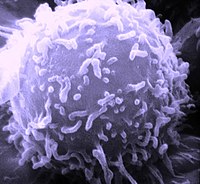
Photo from wikipedia
The kinase IRAK1 senses the cytokine load to prevent overstimulation of the immune system. Keeping a check on the infection response The innate immune system responds to various cytokines and… Click to show full abstract
The kinase IRAK1 senses the cytokine load to prevent overstimulation of the immune system. Keeping a check on the infection response The innate immune system responds to various cytokines and other “danger signals” that occur during infection. These must be properly identified and responded to; however, too much stimulation of the immune system can have debilitating consequences and cause autoimmune disease. Using live-cell biosensors and optogenetics, DeFelice et al. identified a regulatory feedback loop in one such immune signaling system mediated by cytokine receptors through the protein NF-κB. They found that the protein IRAK1 acted as a sensor of the amount of cytokine stimulation such that a high amount of stimulus elicited IRAK1-dependent inhibition of NF-κB activity, whereas low amounts of stimuli elicited oscillatory patterns of activity. The findings place IRAK1 at the central controls of the overall immune response to infection and may explain why mutations in IRAK1 are associated with rheumatoid arthritis. Over the last decade, multiple studies have shown that signaling proteins activated in different temporal patterns, such as oscillatory, transient, and sustained, can result in distinct gene expression patterns or cell fates. However, the molecular events that ensure appropriate stimulus- and dose-dependent dynamics are not often understood and are difficult to investigate. Here, we used single-cell analysis to dissect the mechanisms underlying the stimulus- and dose-encoding patterns in the innate immune signaling network. We found that Toll-like receptor (TLR) and interleukin-1 receptor (IL-1R) signaling dynamics relied on a dose-dependent, autoinhibitory loop that rendered cells refractory to further stimulation. Using inducible gene expression and optogenetics to perturb the network at different levels, we identified IL-1R–associated kinase 1 (IRAK1) as the dose-sensing node responsible for limiting signal flow during the innate immune response. Although the kinase activity of IRAK1 was not required for signal propagation, it played a critical role in inhibiting the nucleocytoplasmic oscillations of the transcription factor NF-κB. Thus, protein activities that may be “dispensable” from a topological perspective can nevertheless be essential in shaping the dynamic response to the external environment.
Journal Title: Science Signaling
Year Published: 2019
Link to full text (if available)
Share on Social Media: Sign Up to like & get
recommendations!